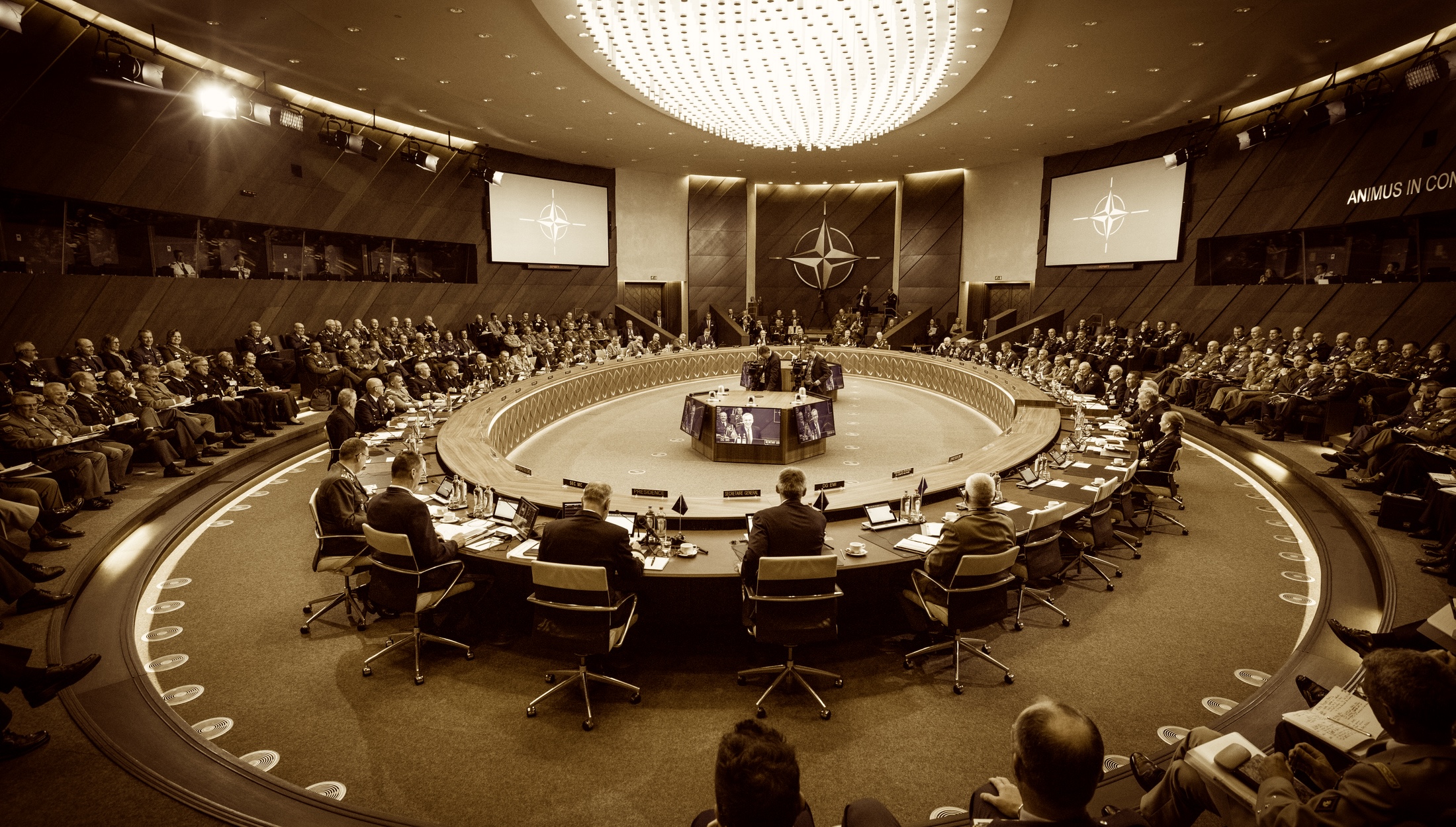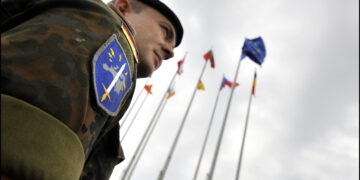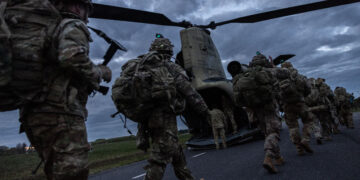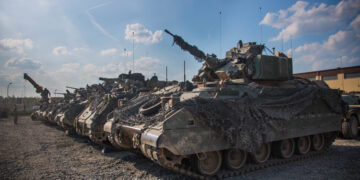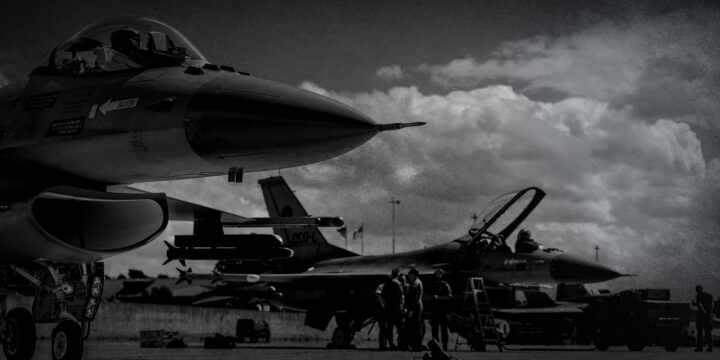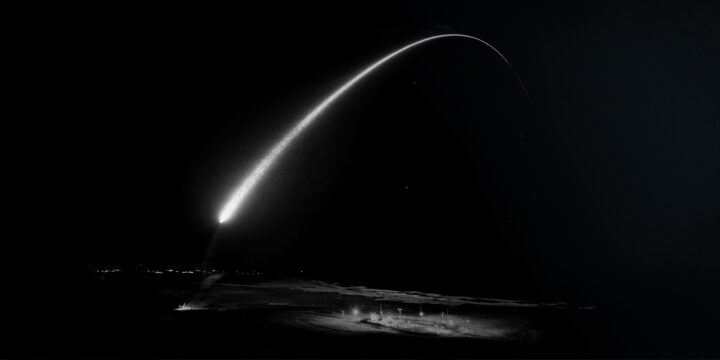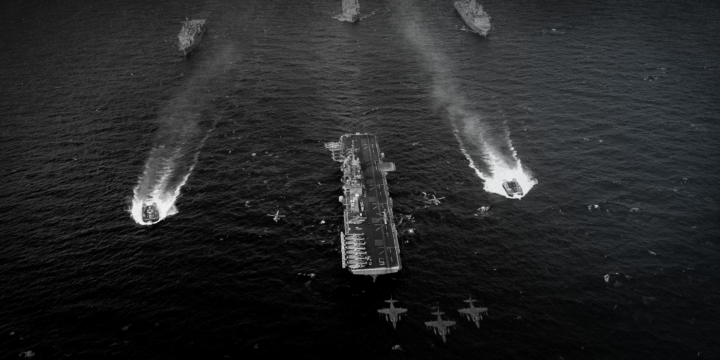Ahead of the Washington, DC, NATO summit, which will mark 75 years since its founding, Defense Priorities (DEFP) organized this symposium to stimulate critical thinking about the military alliance. Top experts shared their insights in an effort to inform and improve U.S. policy. Each contributor provided an answer to the same question: “What is the biggest U.S. policy mistake with regard to NATO?”
The 1990s should not be a nostalgic decade for NATO
U.S. policymakers made their biggest mistake with regard to NATO during the 1990s. Though some might focus their ire solely on NATO expansion, the problem was actually much broader: a choice by the Clinton administration and later the Bush administration to fundamentally re-orient NATO away from collective defense and towards new missions for “the new security challenges of the next century.”
These new missions included peacekeeping in the Balkans, acting as the enforcement mechanism of the UN Security Council in humanitarian missions, and helping to promote liberal and Western norms in Eastern Europe. NATO expansion was one component of this process, but hardly the only part of it: NATO’s member states also retooled their armies for “out-of-area” missions and began to emphasize nontraditional security concerns like terrorism.
This transformation was by no means inevitable. NATO in the 1990s undoubtedly faced a “March of Dimes” problem: that organization, infamously, had put itself out of business by succeeding in its goal to end childhood polio, before pivoting to other causes rather than wind down its operations. NATO had done much the same with regard to the Soviet Union, bringing about its own obsolescence as a military alliance with the collapse of the USSR.
The 1990s was therefore a period of significant questions about NATO’s future purpose: should the United States be in or out of European security? Should NATO continue to exist at all? Could Russia be welcomed back into Europe’s security architecture? Though U.S. policymakers chose to transform the organization into something more expansive and ambitious, one can also imagine a world in which NATO became a more modest, European-only collective defense mechanism.
Instead, U.S. policymakers chose to transform NATO to meet the narrow needs of their preferred policies during the 1990s. This might not have mattered, except that the ways in which NATO was transformed served to undermine its core defensive capabilities. Expansion not only worsened U.S.-Russia relations, but extended U.S. security guarantees to less defensible territory like the Baltics. The number of members in the alliance was doubled, making it harder to achieve consensus. The transition to out-of-area missions made European forces less capable of sustaining their own defense. And the continued strong U.S. commitment to Europe helped to hollow out the European pillar of NATO as part of a peace dividend. At the end of the Cold War, for example, the Bundeswehr boasted more than 500,000 troops; today, it is just over a third of that.
The transformation of NATO during the 1990s into something other than a European collective defense alliance thus made it harder for the alliance to pivot back to its original mission after 2014. Today’s NATO is less defensible, less coherent, and perhaps even more dependent on U.S. capabilities than in the late Cold War. U.S. policymakers bear the blame.
A partial defense of NATO’s 2 percent target
Much of the discussion around defense burden-sharing in NATO has centered on the alliance’s 2 percent of GDP defense spending target. Having been set in 2006, NATO gave the target new emphasis at the 2014 Wales Summit, with members pledging to move toward 2 percent and later recommitting to reaching the target at the 2023 Vilnius Summit.
However, the 2 percent target has many detractors who claim, variously, that it is ineffective, political rather than strategic, and fails to capture key contribution metrics. One can debate the first of these points—there is some evidence that the Wales Pledge has a modest effect on European defense efforts—but the second largely misses the mark and the third is less a reason to scrap 2 percent than it is to build upon it.
Simply put, a burden-sharing target must be political to matter. For there to be momentum to meet any target, key audiences must know about it. Only then can they put pressure on reluctant decision-makers to fulfill their commitments. The more complicated and opaque the standard, the more difficult it is for anyone outside of a narrow range of knowledgeable defense policy elites to be aware of it. Defense policy elites, in turn, are unlikely to be a hard sell on boosting defense efforts in any case.
Thus, an impactful standard must be sufficiently visible and digestible to broader audiences in order to generate pressure to reach it. This includes not only audiences like the public and political elites in countries that fail to meet the standard, but also those in countries that do meet it. Domestic interest in burden-sharing within the United States, for example, is one of the most potent motivations allies have for spending more.
This is hardly to suggest that other standards would not be useful as well. The alliance already has a target for spending 20 percent of defense outlays on equipment, which could be complemented by further output-oriented standards.
Ultimately, the 2 percent standard is neither necessary nor sufficient for encouraging European NATO members to assume more responsibility for their own defense. It is no coincidence that efforts to meet the standard gained momentum after Russia’s annexation of Crimea in 2014 and again after its full-scale invasion of Ukraine in 2022. Members that feel more acutely threatened—including Poland and the Baltic states—are in turn likely to continue exceeding 2 percent.
Historically, the United States has in some cases turned to more coercive approaches, such as threatening to abandon allies unless they increase defense spending. Nevertheless, the 2 percent standard is a useful mechanism short of coercion for encouraging partners who might otherwise be reluctant to boost their defense spending.
NATO's three worst decisions
Perhaps the biggest mistake the United States made with regard to NATO occurred after the Soviet Union collapsed but before the first tranche of expansion. The bitter fruit of the seeds planted then are now on painful display.
On June 18, 1997, one month before the Senate voted on the first round of NATO enlargement, then-senator Joe Biden gave a speech at the Atlantic Council on the future of foreign policy. In voicing his support for NATO expansion, he tried to parry the argument that expansion would prompt a negative reaction from Russia.
With great confidence, Biden argued that not only would Russia not resist eastward expansion, but also they would welcome it. The many Russian officials with whom Biden had personally met “all understood” the “nonaggressiveness implicit” in NATO’s assurances that it had “no reason, intention, or plan” to place nuclear weapons “or substantial combat forces of current members on the territory of new member states.”
Well, not all Russian politicians accepted that, Biden admitted. In a mocking tone, he acknowledged meeting with two senior Kremlin officials who declared “they don’t want this NATO expansion, they know it’s not in their security interests, and on and on and said ‘well if you do that we may have to look to China.’ And I couldn’t help but using the colloquial expression from my state by saying ‘lotsa luck in your senior year!’ You know, good luck.” Then, prompting derisive laughter from the audience, he added, “and if that doesn’t work, then try Iran.”
Biden’s cringeworthy comments didn’t end there: “And they know, and I knew, and they knew, everybody knows, that [moving toward China and Iran] is not an option. And everybody knows, every one of those leaders acknowledges and needs—and they resent it—but they need, they need to look West.”
As it turned out, Russia did not need to look West, and they have indeed powerfully aligned themselves with both China and Iran (recently adding a military pact with North Korea).
The second biggest mistake was in promising NATO membership to Ukraine in 2008. Combined with the slow boil started with the first round of expansion in 1997, that lit a fuse that eventually resulted in Russia launching a war of aggression against Ukraine in 2022. As I have previously written, while Putin was fully in the wrong for starting the war, it was painfully obvious our policies were negligent and pushed Russia in that direction.
The next big mistake we could make is to continue with the egregious, ill-conceived, and bull-headed drive to keep trying to extend NATO membership to Ukraine. Doing so will undermine U.S. security and will almost certainly convince Putin his only recourse is to win the war on the battlefield, dooming Ukraine and an entire generation of her men to death. In a worst case, the United States itself could get drawn into a war, which would be catastrophic for our security. It’s time to end our penchant for self-destructive policies.
The U.S. should get out of Europe’s (and its own) way
Lord Hastings Lionel Ismay, NATO’s first secretary-general, famously said that the purpose of the transatlantic alliance was to “keep the Soviet Union out, the Americans in, and the Germans down.” It succeeded on all three points with flying colors. By the time the Soviet Union dissolved in December 1991, Washington was the most integral component in European security, Germany was highly dependent on the Americans for security, and the Soviets were, well, in the history books.
In the initial decades of the Cold War, it made sense for the United States to lead Western Europe’s defense. The Europeans, still exhausted after World War II, couldn’t do it themselves. Preventing Soviet hegemony in Eurasia was a core objective of U.S. grand strategy at the time.
Yet things have changed markedly in the 33 years since the Soviet Union fell apart. With the exception of the ongoing war in Ukraine, in which Russia is struggling to gain ground despite having more of everything compared to the Ukrainians, Europe generally remains peaceful and prosperous. While inter-state rivalries are still there, the European Union project has managed to bring the continent together on the big strategic questions. The EU’s economy is now in the same league as America’s, no small feat given that Europe had to start from scratch more than 80 years ago.
The United States, however, continues to operate as if Europe is a helpless child, too inexperienced and stupid to make its own decisions—even though it’s the Europeans themselves who best understand their own neighborhood and have the greatest stake in getting it right. U.S. officials throughout the foreign policy bureaucracy are seemingly incapable of allowing European allies to take charge of their own security, arguing that U.S. leadership is absolutely essential to keep the continent whole, free, and at peace. The United States lectures Europe to increase its defense spending but simultaneously complains whenever a European head-of-state (like French President Emmanuel Macron) tries to promote strategic autonomy and rely less on Washington.
In the end, everybody loses. Europe becomes ever more dependent on the U.S. military for the most basic aspects of defense, the precise opposite of what Washington should be doing (building credible and capable allies). And the United States, through NATO, is forced into the role of Europe’s permanent guardian, even as other priorities—competition with China, periodic crises in the Middle East, and a $34 trillion national debt to name a few—remain on the table.
U.S.-led NATO is still keeping the Russians out and the Americans in. But it’s also deliberately keeping Germany and the rest of the Europeans down by disincentivizing self-sufficiency in the defense realm. The United States is its own worst enemy on this issue and ought to get out of its own way.
NATO's Buddenbrooks moment
“Often, the outward and visible material signs and symbols of happiness and success only show themselves when the process of decline has already set in. The outer manifestations take time – like the light of that star up there, which may in reality be already quenched, when it looks to us to be shining its brightest.”
― Thomas Mann, Buddenbrooks: The Decline of a Family
NATO boosters have had a good run over these past 30 or so years. A little more than 40 years after the alliance’s founding to contain the Soviet Union, the Berlin Wall had fallen; the Warsaw Pact, reflecting a shift from the Brezhnev to Sinatra Doctrine, splintered and the former members went their own way; and the Soviet Union itself imploded, fortunately not with a bang but with a whimper. It would subsequently prove that like Mark Twain, and despite prognostications to the contrary, reports of its imminent demise were at best premature.
Indeed, despite the Cold War ending, there was even greater interest among European nations in joining NATO, with 14 new countries becoming members, doubling its size. Most recently, in the face of Russian aggression against Ukraine, the alliance stood together, and even added two more members from among historic neutrals. The NATO star now seems “to be shining its brightest.”
But do these “outward and visible material signs and symbols of … success” indicate NATO’s robust health? Or might they, like the apparent splendor of Thomas Mann’s Buddenbrooks family, actually conceal a rot and decline that have already set in?
Evidence that NATO is having its Buddenbrooks moment is not hard to find if you look past the glamor and glitz of new members and high-profile summits. For example, NATO’s raison d’etre is to increase the security of its members. Believing that, with the end of the Cold War, many newly freed captive nations rushed to shelter under its umbrella despite facing only a democratizing, Western-oriented, and much diminished Russia. Perhaps the Bear would have eventually returned to his bad, old, imperial ways no matter what, but it is hard not to suspect that in the process of responding to a hypothetical Russian threat, the alliance’s expansion, in some cases right up to Russia’s borders, created a self-fulfilling prophecy of Russian hostility. The Ukraine war is clearly about NATO expansion, as John Mearsheimer has shown, and no amount of diplomatic and punditry pettifoggery can paper over that fact.
NATO, of course, is not supposed to be a vehicle for domestic reform and democratic consolidation, but the hope that membership and good politics might have an “elective affinity” has been there from its inception. The reality has been that NATO has had to accept that crucial members—Greece and Turkey—might at times not meet those high community standards. For many new members, democracy and good government have been more aspiration than reality, Sweden and Finland notwithstanding.
Finally, while the recent Ukraine peace summit in Switzerland was not a NATO undertaking, most NATO members were a part of it. Here again, the light seems to be shining brightly, but only if you look past the fact that the many states that attended sent relatively low-level representatives (Vice President Kamala Harris managed to drop in between state funerals). Not only was Russia, one of the two main belligerents in the Ukraine war, uninvited, but the rest of the BRIC countries—Brazil, Russia, India, China—were either not there (China) or did not sign the summit’s final document (Brazil and India). We’d like to think that the rest of the world stands with NATO behind its Ukraine project, but the reality is that it does not—or at least not very tall when it does so.
Forgetting what NATO is for
The United States entered NATO to enhance its own security by balancing Soviet power. But U.S. leaders, especially since the Cold War’s end, have forgotten that purpose. Instead they’ve come to view the alliance either as means to dominate Europe or an end in itself, something to celebrate rather than evaluate.
The cost of this error has been substantial: allies infantilized, largely by design; massive opportunity costs plus wealth transferred from U.S. taxpayers to Europeans; and the expansion of NATO to the point of dysfunction, which predictably worsened the Russian threat NATO exists to confront.
NATO started as a way to use U.S. power to buttress European states, especially West Germany, against the communist threat. The point was not to exercise U.S. power in Europe but to prevent Soviet expansion. The animating worry was that Soviet armies would sweep across more of Europe, vassalizing it as they had the east. Another fear was that post-war poverty, combined with the heavy military spending required absent U.S. help, would provide openings for communist parties to take power through internal means. Should either occur, the Soviets might imperil the United States by taking control of Western Europe’s industrial might and using it for a direct attack—or, more realistically, shutting down trade with the United States and forcing it into a defensive crouch as an economically crippled “garrison state.” Stationing troops in Europe (more than 400,000 in the early Cold War), threatening to wreak mass destruction with nuclear weapons, and providing economic aid through the Marshall Plan were prongs of the balancing effort.
In retrospect, both the internal and external threats of a communist takeover of Europe were widely exaggerated, even in the early Cold War. Certainly European states managed to recover and then some, while Soviet military advantages waned. Had the United States maintained the balancing policy it had at the start of the Cold War, it would have begun pulling forces from Europe well before the Cold War ended. Whether or not the Europeans increased their own efforts, the balance would have held. The United States did remove roughly two-thirds (or 200,000) of its forces from Europe following the Soviet Union’s collapse, but this was overly cautious given the decay of the threat these forces were supposed to balance.
What changed? Essentially the U.S. elite fell victim to its own Cold War propaganda. To sell Americans on the virtues of the Cold War, U.S. leaders marketed NATO as something more than a simple effort to block Soviet military expansion. One rationale was that NATO served to embed U.S. influence in Europe, partly by keeping allies dependent, too weak and divided to provide a rival power bloc. A related idea, more popular on the internationalist left, was that the U.S. role in NATO undergirded a liberal international order, one that turned on U.S.-led international cooperation. The idea that NATO runs on mass terror—the threat to annihilate one foreign country on behalf of some others—became uncouth.
Forgetting what NATO is for has had various consequences. Via NATO, the U.S. has basically blocked Europeans from developing independent military capacity (what we now call strategic autonomy). Abandoning balancing and putting NATO on a pedestal prevented an overdue drawdown of U.S. forces there, and hence big savings through force structure reduction. It also enabled NATO’s serial expansion, which has proven a slow-motion security disaster. Expansion brought a series of increasingly infeasible and costly defensive requirements; new allies enabled in recklessness thanks to undue confidence in American backing; and increased Russian hostility, most consequentially toward Ukraine where the prospect of NATO expansion, de jure or de facto, helped cause the 2022 invasion.
NATO should have taken the win
NATO’s biggest mistake was that it failed to “take the win” in the 1990s. During the Cold War, NATO had a genuine purpose—defending Western Europe against the Soviet threat—that allowed it to handle difficult issues where judgments about the best policy differed among its members. Divisions over how much to rely on nuclear weapons, what types of nuclear weapons to deploy, how much each alliance partner should invest in defense, the acuteness of the Soviet threat, and the best conventional military doctrine to fend off that threat were all serious, but the alliance’s focused mission always offered an incentive and a means to adjudicate the controversies.
But after the collapse of the Soviet Union removed the threat, NATO had no clear reason to exist anymore. NATO won. But its member countries, feeling triumphant and not facing a clear strategic constraint, didn’t react in the best way.
Instead of feeling grateful, humbled by their success at holding off the threat for decades without getting into World War III, conventional or nuclear, they threw prudence to the wind and flailed around for new missions and new members. NATO should have gracefully disestablished when its core reason for existence disappeared. It should have faded along with its Soviet-led Warsaw Pact opponent. The mistake was to assert roles in out-of-area operations and new humanitarian missions as a way to vaguely justify the alliance, with many new slogans and much pomp at summit meetings that papered over internal divisions. The slogans made other countries feel threatened, and the new transformational missions were predictably impossible to complete.
Today, NATO is an off-balance-sheet liability: the old promises to fight are still there, but none of the members have really contemplated the circumstances in which they would actually be willing to fight or readied themselves to pay the costs. If advocates wanted a new alliance after the Cold War for new purposes, they should have proposed it and decided on its members, rather than just holding them over from a past agreement. They should have publicly argued about the new alliance’s potential rewards, costs, and risks. But they never did, because NATO did not take the Cold War win. We should have let NATO sunset in the 1990s.
Assuming a larger role in Asia-Pacific security
NATO countries are assuming an ever-larger role in Asia-Pacific security. This summer, the Italian aircraft carrier Cavour is on its way to Japan, intended to “ensure stability in the Indo-Pacific.” In July, air force contingents from Germany, France, and Spain will also visit Japan for joint maneuvers.
Meanwhile, South Korean and Japanese leaders have become regular attendees at NATO summits, and will be present at the summit this July. NATO’s leader, General Jens Stoltenberg, has made visits to Northeast Asia and there has even been talk of setting up NATO offices in the region. These activities do not support U.S. or European interests in the Asia-Pacific. Nor do they uphold security in that volatile region. NATO’s lean into Asia is based on a number of mistaken judgments.
It is common sense that European militaries and NATO itself should focus on preparing for military contingencies in Europe. The Ukraine-Russia war has amply illustrated that European armed forces are under-resourced and unprepared for major combat within Europe. How does it make sense to spend scarce recourses in distant locations and in possible contingencies wherein European interests are limited?
NATO’s lean into Asia has already resulted in substantial strategic setbacks for the U.S. and global security by fundamentally strengthening the nascent China-Russia quasi-alliance. With some familiarity of Chinese military thinking, it is not difficult to discern Beijing’s perspective that NATO’s activities in the Asia-Pacific are unwelcome and unnerving.
Meanwhile, European comments on Taiwan—including efforts to link the Ukraine and Taiwan causes—have only seemed to make the Taiwan situation more acute, eliciting vitriolic responses from Beijing. Against this background of evident China-NATO hostility, it’s no surprise that China has taken a distinctly pro-Russian position of neutrality with respect to the Ukraine war and that the China-Russia quasi-alliance is developing quite smoothly. The Russia-North Korea strategic partnership is even more dynamic and likely has similar causes.
A few more arguments against NATO involvement in Asian security should be noted. Europeans deploying military forces into the Asian region carries the distinct and unpleasant odor of previous historical periods of rampant and brutal European imperialism in the region. Americans may not recall this history, but Asians surely do. Another major problem is that NATO countries have frequently enabled major U.S. strategic mistakes by lending them a veneer of legitimacy. For example, one has to wonder if the U.S. intervention in Afghanistan would have lasted so long—20 years—if Europeans had not been duped into joining that misbegotten enterprise. NATO should not help enable the next Asian war, which could turn into a nuclear conflict, through this deleterious “cheerleader” effect.
Finally, and most decisively, Europe’s forces are simply irrelevant to the deterrence calculus with China—a reality well understood in Beijing. Even if they had the appropriate forces, NATO contingents could not be sustained at such a distance from Europe. Skittish European publics would be certain to abhor the enormous costs that a war with China would entail. Most particularly, the kind of naval forces that NATO countries have been deploying into the Pacific would quickly be destroyed by China’s formidable anti-access arsenal. While British and French nuclear submarines do indeed form a partial exception, there are far too few of those prized assets to make a decisive difference. Indeed, a recent report shows the Royal Navy has trouble keeping its “small force” out at sea on a regular basis and the trends are not favorable.
Albright's 3Ds: Dependency, dependency, dependency
NATO’s upcoming summit will champion a familiar narrative: the United States will reaffirm its “ironclad commitment” to Article 5 and collective defense, Europe will recommit to larger defense budgets, and together they will extol the strength and unity of the 75-year-old alliance. The same old script results in the same old problems. There is no end in sight for Europe’s dependence on the United States.
Twenty-five years ago, then-secretary of state Madeleine Albright warned that the alliance would only remain strong and cohesive if there was no decoupling of European defense structures from NATO, no duplication of NATO capabilities, and no discrimination against non-EU NATO members. This narrative is so well entrenched that U.S., NATO, and even EU officials routinely invoke the “3Ds” in defense policy debates.
But NATO lost the plot along the way. Europe limited its defense ambitions in response to Washington’s opposition, and while allied unity was preserved, the alliance itself grew “unbalanced.” First, the “no decoupling” rule has discouraged European allies from fully leveraging the EU’s comparative advantages, especially its funding and financing mechanisms. When the EU released its Defense Industrial Strategy, to include an initial budget of €1.5 billion ($1.61 billion), and indicated it would “explore all options” to increase funding, NATO Secretary-General Jens Stoltenberg pushed back, warning, “You cannot have [the] EU and NATO presenting to Germany, or to Denmark, or to Poland two conflicting lists of capability targets.”
Second, the “no duplication” guideline imagines one threat—the EU duplicating NATO’s role—while ignoring the all-too-real problem of Europe’s defense fragmentation. European allies collectively spent about four times as much as Russia last year on defense, despite Moscow’s surge in wartime defense spending. There is no reason why Europe cannot come to its own defense, except it spends its funds so inefficiently. For instance, European allies collectively have 17 different types of main battle tanks, 13 different types of air-to-air missiles, and 29 different types of naval frigates.
Finally, the “non-discrimination” principle has become synonymous with advancing the interests of U.S. defense firms and stymying any progress toward European defense industry consolidation. Washington has long insisted that Europe keep its defense market open to U.S. firms without reciprocating in kind. While allowing U.S. companies to compete for European contracts makes good business and economic sense in Washington, it offers little incentive for European publics to support larger defense budgets when they line American business pockets.
NATO should flip the script. Instead of Albright’s “3Ds,” it should embrace what Marie Jourdain and I call the “3Cs”—cooperation, capabilities, and consolidation—to build a stronger European pillar in NATO. The top priority should be deepening EU-NATO cooperation, in which NATO sets standards and procurement targets while the EU coordinates investment and procurement. Strengthening European military capabilities will also likely require joint EU borrowing, similar to the European Union’s €800 billion ($857 billion) post-COVID recovery plan. Importantly, European allies should work to consolidate their defense industrial base, and the only way to achieve that is for Europe to wean itself off American kit and build its own. Seventy-five years on, NATO ought to reinvent itself into an alliance of equals.
Retire the 2 percent of GDP military spending target
“Only seven of the NATO allies spend more than 3 percent of their gross domestic product (GDP) on defense,” then-undersecretary of state for political affairs Nicholas Burns complained to reporters before the 2006 NATO Summit in Riga, sounding a familiar refrain about the need for more European defense spending. Days later, Washington won a victory of sorts, with NATO members agreeing for the first time to a defense spending target of 2 percent of GDP. However, the adoption of the 2 percent target did little to increase allied spending in the years after 2006—or after 2014, when member states reaffirmed the goal. Since Russia’s 2022 invasion of Ukraine, European defense investment has increased, but many states still fall short of the target.
By focusing narrowly on level of spending, the 2 percent of GDP goal has harmed rather than helped alliance burden sharing. European NATO allies do need to spend more on defense, but spending smarter, with coordinated defense investments and capability-based goals tied to shared defense gaps, should be the higher priority.
The 2 percent of GDP target is counterproductive for three reasons. First, it is arbitrary, detached from any assessment of real national defense needs. For some countries, spending 2 percent of GDP may be sufficient to meet security requirements. But for most others, including those that have neglected defense investment for decades or border Russia, 2 percent of GDP will not be enough. Poland and the Baltic States have come to this realization and are increasing their defense spending to 3 to 4 percent of GDP, but other most states, including Germany and France, lag far behind.
Second, the 2 percent target has put spending more money ahead of spending money on the right things. Germany, for instance, increased defense spending from 1.3 percent to 1.5 percent of GDP between 2021 and 2023, but that increase was entirely absorbed by the purchase of 35 F-35s. Since Europe already far surpasses Russia in its number of combat aircraft, Germany’s and Europe’s security would have benefited more from investments in air defense, fortifications like anti-tank mines, and munitions. These capabilities might have cost less but would have offered greater security returns on a faster timeline.
Third, the use of a national-level spending target has done little to encourage the coordinated spending required for an independent European defense pillar. The European Union—whose membership overlaps with NATO—has a limited defense budget, and even as national-level spending increases, European defense investment is still plagued by fragmentation and gaps at the collective level. European NATO members have dozens of different types of tanks and combat aircraft, but only 5 percent of the air defense needed for a war with Russia. Ultimately, spending together will be as important for Europe as spending more.
Heading into the NATO summit in Washington, some members have advocated for an increase in the defense spending target to 2.5 percent or even 3 percent of GDP. Instead, Europe should change how it spends on defense. First, the EU needs a larger defense budget to address shared defense needs and incentivize joint purchases by members. Funds could be raised through EU joint bonds, as was done to support the bloc’s COVID-19 programs. Second, NATO member states should be given capability-focused targets—number of air defense systems or quantities of precision munitions—aimed at filling high-priority European defense gaps. Defining these targets will be harder than using spending goals, but this approach can achieve more burden sharing in the long run.
Transitioning NATO from a defensive to an expansionist alliance
The greatest U.S. policy mistake with regard to NATO after the end of the Cold War was to change it from a defensive to an expansionist alliance, without setting limits to that expansion or seriously considering its risks.
During the Cold War, successive U.S. administrations, starting with Eisenhower’s in 1953, rejected a strategy of “rolling back” Soviet power in Eastern Europe by fomenting revolutions backed by military force. The Soviet Union took the same decision with regard to Western Europe.
The calculus on both sides was the same: because Europe was an area of vital interest to both superpowers, any attempt to force a change of strategic frontiers or launch proxy wars there would be bound to lead to war, with a high chance of escalation to mutual nuclear annihilation.
Both sides did seek to expand or defend their spheres of influence in Asia, Africa, and Latin America through revolutions, coups, and proxy wars, but (with the partial exception of Central America for the United States) these were areas of secondary strategic interest to both.
On the Soviet side, this reflected the fact that Eastern Europe neighbored their own territory and had been the base for repeated invasions of Russia. On the U.S. side, it reflected the fact that Western (and to a degree Central) Europe form the eastern littoral of the Atlantic Ocean, from which the United States could be threatened, and that this region has been one of the great economic centers of the world, and a crucial market for U.S. goods.
The United States therefore could not permit a hostile or potentially hostile superpower to dominate these areas, just as Russia cannot tolerate one to dominate territories on its immediate borders. Nor was there anything mysterious about this thinking on either side. Both Russians and a long list of leading U.S. experts on Russia warned for many years that the expansion of NATO, unless it stopped short of Ukraine and Georgia, would very likely lead to war.
The other U.S. mistake—which to a great extent stemmed from the same “End of History” ideological hubris as did NATO expansion—was to fail to anticipate the huge economic growth of China, coupled with the status expectations stemming from 2,500 years of Chinese history, would inevitably lead China to seek a much more powerful position on the world stage. Unless the United States were prepared to make really serious attempts to accommodate this, increased tension was bound to result. Clear strategic thinking would therefore have dictated avoiding new U.S. strategic commitments elsewhere.
As a result of these mistakes, the United States now finds itself engaged in an indefinite proxy war in Ukraine, where (despite initial Russian disasters) the long-term odds are strongly stacked in Russia’s favor. Defeat in Ukraine would not damage any really vital U.S. interests, but the threat to its “credibility” (that addictive establishment phrase) could still lead the United States into the sort of terrible dangers that it avoided during the Cold War.
A temporary measure to protect a ruined Europe from Soviet predation, turned permanent
Asking about Washington’s biggest policy mistake regarding NATO is like asking about Kanye West’s most inscrutable TMZ appearance. One doesn’t know quite where to begin, but when you do, you stumble across a bounty of historic errors.
Presentism will bias here as much as it does anywhere. For example, post-Cold War NATO expansion—in particular the 2004 round—would be an excellent candidate for worst U.S. NATO decision. In 2003, the U.S. Senate voted 96-0 to admit an array of mostly small, weak, geographically vulnerable states to the alliance. The Senate did so without even superficial debate, without any discussion of these countries’ defense requirements, and with hardly any mention of Russia. (In 2010, Wikileaks revealed that NATO did not even have a plan for defending the Baltic states until they begged for one after Russia invaded Georgia in 2008.)
At the time, American leaders said the Baltic states deserved to join the alliance because they supported the invasion of Iraq and went along with the Bush administration’s war on terror. Now, the difficulty of defending those countries has become a central justification for the idea that the United States can never leave Europe.
But the unseriousness during that frivolous era is the offspring of the original sin of U.S. NATO policy: a larger, foundational error committed during a much more serious time.
The alliance had been designed, and marketed to the American people, as a temporary measure to protect a ruined Europe from Soviet predation and allow it to rebuild. While American protection via NATO (and money via the Marshall Plan) helped clean up the ruins, the Eisenhower administration tried to build up a so-called “Third Force” in Europe that could relieve the United States of the responsibility for an outsized share of Europe’s defense. But the European Defense Community, the institutional embodiment of this effort, was voted down by the French National Assembly in 1954, and the U.S. effort to burden-shift went into hospice and ultimately died.
One of the most powerful forces in social and political life is inertia. After the French killed the EDC, American policymakers allowed the allies to pull the United States ever deeper into Europe. The Soviet Union served as the original justification, but even after its collapse, the Americans remained the cornerstone of European defense efforts, to the point that on NATO’s 75th birthday, Europeans still plead helplessness without Uncle Sucker in the driver’s seat.
Eisenhower famously said in 1951 that, “If in ten years, all American troops stationed in Europe for national defense purposes have not been returned to the United States, then this whole project will have failed.” While there is blame for this failure on both sides of the Atlantic, U.S. policymakers allowed it to happen.
Expanding NATO was a staggering strategic blunder
The expansion of NATO to include former members of the Warsaw Pact and the Soviet Union was the United States’ greatest strategic mistake with regard to Europe in the post-Cold War era. But “NATO expansion” was not just a single policy decision. It was a process, borne from the attempt to consolidate U.S. global hegemony, that set in motion a whole series of further policy blunders with consequences that now extend beyond Europe.
The function of NATO during the Cold War was to contain the Soviet Union. After the collapse of the Soviet Union, the United States should have helped build a new European security architecture that could replace the Cold War-era military alliance of NATO, facilitate cooperation with post-Soviet Russia, and allow the United States to eventually disengage its forces from the continent.
NATO expansion, however, made clear to all—especially to Moscow—that the purpose of maintaining the alliance was to extend the U.S. sphere of influence in Europe at the expense of Russia’s strategic buffers. By making NATO, under the continuing aegis of Washington, the central conduit for post-Cold War European security, any efforts towards a security architecture that included Russia were bound to be overshadowed by the initiative to install the United States as the permanent police force of Europe.
A series of foreign policy experts foresaw with striking prescience at the time what was to come. Most notably, George Kennan warned that “expanding NATO would be the most fateful error of American policy in the entire post-cold-war era,” and that it would “restore the atmosphere of the cold war to East-West relations.”
NATO expansion was not the only reason for the souring of U.S.-Russian relations. The United States’ leaving of Cold War-era arms control agreements and regime change operations around the world also played a significant part. But Moscow repeatedly made clear that they perceived NATO expansion as a vital security threat, and policymakers in Washington proceeded anyway.
As former ambassador and current CIA director William Burns put it in 2008, “Ukrainian entry into NATO” was “the brightest of all red lines” for Russia. Ukraine is now being dismembered and its youth sacrificed. The world’s two largest nuclear powers are at the greatest risk of direct conflict in at least four decades. Russia, which has numerous geostrategic reasons to be at odds with China, has instead been incentivized to align with Beijing, the United States’ most significant strategic competitor. This will surely be considered one of the most staggering strategic blunders in American history by future historians.
To quote former defense secretary Robert Gates: “NATO expansion was a political act, not a carefully considered military commitment, thus undermining the purpose of the alliance and recklessly ignoring what the Russians considered their own vital national interests.” To extricate itself from this mess, the United States should steadily shift responsibility for European security back to Europe itself, help negotiate a settlement of the war—and make clear that Ukraine will not be admitted into NATO.
Washington's broken watches
U.S. policymakers, and indeed most commentators, journalists, and academics alike, seem to wear broken watches. They appear to believe we’re still in the early decades of the Cold War. Back then, a war-ravaged Europe needed time to recover. Europeans feared the Red Army, whose reach had extended into Eastern Europe, as well the possibility of a revanchist Germany.
That era belongs to the distant past.
Today, Europe ranks as one of the three leading centers of wealth and technological prowess in the world—the United States and China are the other two—yet in Washington, the myth that Europeans cannot defend themselves abides. Never mind that all of the most commonly used indices for gauging power show this is baseless. Whether within NATO or independently, Europeans can do far more to defend themselves than they have done.
Yet even now, only 18 out of 32 NATO countries are expected in 2024 to meet the defense spending “guidelines” NATO adopted at its 2014 Wales Summit. This is not for want of resources but for lack of will. Oddly, the United States encourages this slothfulness, having convinced itself, as well as Europeans, that Europe would be helpless without American guardianship. It’s high time for greater European defense autonomy. Perhaps Russia’s invasion of Ukraine will be the catalyst for change. But for that to happen, established thinking must change—not just in Europe but in Washington, too.
A NATO error and its ripple effects
Senator Richard Lugar famously declared in August 1993 that “NATO will either develop the strategy and structure to go ‘out of area’ or it will ‘go out of business.’” It did go out-of-area, and did so under energetic U.S. leadership. This contributed to missed opportunities and self-destructive defense planning in Europe and exacerbated international tensions.
The principal negative consequence has been the infantilization of the United States’ European partners. At that time real threats to European security did not exist. The civil wars in Bosnia and Kosovo were terrible for the people who lived there, and the refugee flows they precipitated were difficult challenges for European states. Europeans wanted a quieter neighborhood. But these problems were not so dangerous and difficult that they could not have been left to the European Community, later the European Union. Yes, the path might have been more tortuous. But this period and these issues would have been good training opportunities for Europeans to develop the political and military sinews of strategic autonomy.
Instead the U.S. worked deliberately throughout this period to ensure that anything of a serious nature on Europe’s periphery would be NATO business, under U.S. leadership. The Washington foreign policy establishment believed that the U.S. should be responsible for European security forever, and that NATO was the right vehicle for this project. They forgot the title of Walter Lippman’s famous book, U.S. Foreign Policy: Shield of the Republic. For them, foreign policy had become a central purpose of the Republic.
The U.S. decision to remain firmly in charge of NATO as it turned to out-of-area missions enabled a strange and destructive bargain. Once the suppression of civil wars and the replacement of authoritarian governments abroad became NATO’s key day-to-day purposes, European militaries were drawn to specialize in peacekeeping, counter-insurgency, and knocking over petty dictators. Most European militaries struggled to sustain, on a long-term basis, even small military contributions to particular contingencies.
During the war in Afghanistan, the armies of Germany, Italy, and the United Kingdom focused essentially on rotating a single brigade into and out of that country. This consumed most of their “readiness” funds, because all of their brigades were either getting ready to deploy to Afghanistan, deployed, or recovering from deployment. Yet so long as this contribution was made, the U.S. did not inquire much as to what was going on in the remainder of these militaries. Having re-committed itself to NATO leadership, the U.S. was left with ultimate responsibility for European defense. Europeans counted on it and banked a juicy peace dividend.
New missions in the Indo-Pacific
NATO has been one of the most successful security alliances in world history. However, as we assess the alliance on the occasion of its 75th anniversary, we need to distinguish between NATO during the Cold War and NATO in the post-Cold War era. NATO provided its greatest value when the Soviet threat seemed particularly dangerous and the implications of the nuclear revolution were less clear. With the demise of the Soviet Union and the end of the Cold War, NATO was both a lot less relevant to U.S. security while the costs and risks of the alliance increased.
Unfortunately, the alliance committed mistake after mistake in the decades since 1991. Foremost among these errors has been expanding NATO ever further eastward by adding new members and then expanding its mission beyond defense of its member states. The former added commitments that were much harder to justify and even harder to militarily defend. The latter implicated the United States in missions that were important to some of our European allies but not vital interests for Americans. Kosovo was relatively low cost, but a distraction; Libya was an underrated disaster. Europe’s rational free-riding and buckpassing in the post-Cold War world has only added to the feeling that NATO isn’t a great deal for the U.S.
As we look forward to the future, NATO’s next error could be adding new missions in the Indo-Pacific, distracting itself from its core obligation in Europe and making still more promises it can’t keep. NATO’s role in Asia, specifically regarding China, is admittedly still being debated. Some countries have balked at NATO doing more in Asia, opposing even minor steps like opening a NATO office in Toyko. But as David Sacks of the Council on Foreign Relations recently noted, some “believe that NATO has a role to play in bolstering deterrence in the Indo-Pacific and preventing Chinese adventurism in the region.” This follows years in which China has crept onto NATO’s agenda, despite many member states failing to meet their basic defense spending obligations, and showing their flaws at supporting requirements even in NATO’s near abroad during the current war in Ukraine and during the Libya campaign a decade ago. An alliance that cannot function well in its own neighborhood should not be searching for new roles far out of area.
Part of the problem of adding a new NATO role in Asia is that European interests in countering China are not strong enough to suggest their commitments will be credible. This is particularly the case when it comes to supporting regional actors like Taiwan. Indeed, one could question whether European NATO members will even be able to stand united on a common policy towards China given differences between members states in how they define their interests in the region, especially on the economic front. So even if the United States feels that Taiwan is worth fighting for during a cross-strait conflict, will Europe really be there for us and them? And even if, in the highly unlikely event that a united Europe wants to support counter-Chinese efforts there, will they be writing checks they can’t cash? Namely, do the other NATO states really have the national will and capabilities to significantly support combat operations thousands of miles away from their home bases? And what is their incentive to build these capabilities, especially if Russia remains the nearby challenge?
If the United States, assisted by its allies in Europe and elsewhere, wants to continue to pursue a grand strategy of primacy, it would be more useful for NATO to maintain a laser-focus on Europe. As many observers have noted, if our European NATO partners could do better there, both in terms of alliance burden sharing and burden shifting, it would allow the United States to truly pivot to Asia. The United States could thus focus its military, economic, and diplomatic efforts on China. And from a restraint perspective, a Europe that expands its focus and resource allocation across the globe will find it harder to do what it needs to do at home to allow the U.S. to reload in the Western Hemisphere. NATO, with its limited resources, should stick to its knitting in Europe rather than get distracted and tangled up in Asia.
What NATO could learn from the fall of Rome
Professor Al Bernstein did more than any other teacher to shape my thinking on international politics. His influence was perhaps a bit strange, because Professor Bernstein was a classics professor. But he held to the view, not very common in our fastidiously modern existence, that the classical world had a lot to teach us about our current politics. He fascinated generations of military officers and government officials at Cornell, the National Defense University, and SAIS with lurid tales and profound lessons out of Thucydides and Polybius.
Al’s approach is surprisingly relevant to the question of what NATO’s biggest mistake was. He had a particular view of the errors that Roman republican leaders had made that caused their descent into tyranny during the first century BC. Roman strategists had indeed realized the dangers that expansionism posed to their republican system. They knew that a large empire would create so much individual wealth that it might enable dictatorship. To combat this, they tried to discourage conquest and expansion by making consulships—the highest elected political office in Rome—last for only a year. But these limited terms created a perverse incentive for consuls to expedite their conquests, looting a province quickly before their year was up. The next year, the new consul would try to conquer yet another province.
In other words, political and bureaucratic incentives meant the Roman Empire had a policy of non-expansion that was remarkably unsuccessful. The Romans built a great empire, but in the process they destroyed what was precious to them: their republic. They became an empire and then a tyranny.
NATO is not tyrannical. But one can’t help but notice that it too has had a policy of non-expansionism that has been remarkably unsuccessful. At almost every stage of NATO expansion, U.S. strategists recognized that expansion of NATO would lead it to take on obligations it could not fulfill and erode the core of what they valued in NATO. But at the same time, a lot of the bureaucratic and political incentives, particularly from diaspora lobbies in U.S. domestic politics and would-be consuls in the national security bureaucracy, pushed toward expansion.
Successive administrations tried various halfway houses—the “partnership for peace” program, bilateral NATO councils, and now “the bridge to membership” for Ukraine and Moldova—that they hoped would lead nowhere. But most of these compromises simply became pathways to membership, despite the original intention. Kimberly Marten of Columbia concluded that that the political and bureaucratic incentives meant that NATO expansion was simply inevitable no matter what any U.S. administration did. As Thomas Friedman noted in 1997, NATO expansion “was a cynical effort to attract votes from Polish, Czech and Hungarian Americans by promising their motherlands membership.”
NATO’s mistake was thus not expansion per se. It was the U.S. failure to find decision-making structures that could elevate long-term strategic necessity over short-term political expediency. Despite Professor Bernstein’s prodigious efforts, we seem to have learned little from the fall of the Roman Republic.
Forgetting what alliances are and how they work
The United States’ preeminent mistake with NATO was the post-Cold War move to forget that the alliance is just that—a military alliance. Military alliances obligate their members to agree to threaten (and potentially wage) war against a clear adversary. They thus require that allies agree that (1) a given adversary is sufficiently dangerous to (2) specific interests that (3) it is worth putting one’s reputation, blood, and treasure on the line.
NATO during the Cold War operated in this manner, with significant attention devoted to acquiring the military tools and taking the diplomatic steps to block the Soviet threat to Western Europe.
After the Cold War, however, U.S. policymakers opted to waive away these fundamental military and security issues. For one, NATO was imagined by U.S. leaders as (in the words of President George H. W. Bush) a political organization that would target “instability” in post-Cold War Europe. Never mind that “instability” is a condition rather than a threat, or that Europe’s post-Cold War problems were economic and political in nature, which NATO was poorly structured to resolve!
Likewise, NATO enlargement—a policy the U.S. strongly pursued—proceeded on the assumption the alliance would never actually have to defend the Eastern European states that, for their part, wanted into the alliance to hedge against Russia. Indeed, U.S. leaders sought to avoid considering the military implications of enlargement throughout the 1990s and 2000s—so much so that the alliance lacked military plans to defend the Baltic members of the alliance into the 2010s.
By the same token, U.S. leaders ignored repeated warnings by Russian leaders that the expansion of a military alliance would imperil Russian interests. They thus failed to take the world as it was, to accept that the United States cannot define other states’ interests for them, and to recognize that enlargement of a military alliance might be considered a less-than-cooperative act. Policy was instead based on the hope that one could have both NATO expansion and quiescent relations with Moscow—even though Moscow’s own warnings indicated this hope was ill-founded.
Above all, U.S. leaders failed to evaluate or explain to the American public what they were on the hook for. We see this not in NATO enlargement itself but in the process by which it was effectuated. With the important exception of the first (1999) round of enlargement, neither U.S. presidents nor the Congress seriously debated whether the merits of expansion outweighed the risks. Congressional hearings glossed over the strategic and military implications; executive branch representatives never delivered supporting hard analyses.
Approvals for expanding the alliance’s roster became rote, in some cases conducted by voice vote, while challenges or criticisms from the occasional member of Congress were treated as beyond the pale. Independent of the merits of enlargement, committing the United States to potentially fighting and dying for even more states merited greater engagement by U.S. leadership.
We live with the consequences of those choices today. The Russia-Ukraine War is in large part a response to NATO expansion. Belatedly, U.S. leaders and the public are realizing the dangerous alley into which the United States’ post-Cold War assumptions have taken it. One hopes they take seriously the wake-up call and cast aside the delusions that have clouded a forthright and honest debate over whether and how NATO services U.S. interests.
Making commitments first and considering the costs later
Washington’s biggest mistake with NATO began as a smashing success. In the 1990s, the United States devised a brilliant method to enlarge the alliance that frontloaded benefits and backloaded costs—leaving it ill-prepared today to contend with the latter.
When the Clinton administration initially sought to expand NATO, it faced daunting obstacles. Cold War divisions were supposed to be healing, but Moscow opposed the enlargement of an alliance historically aimed at Russia. Americans craved a “peace dividend,” but a bigger NATO would create additional defense commitments that made Pentagon leaders balk. If the alliance were going to expand, many central and eastern European governments wanted a way in, rather than being stuck forever on the wrong side of Europe’s new dividing line. Yet the accession process itself was daunting: the Senate would have to approve of new members by a two-thirds vote, and every existing NATO ally would have to agree.
The White House figured out a clever solution, summarized as “small is beautiful” plus “robust open door.” NATO would admit a few states at first while making clear that many more would receive serious consideration in the not-too-distant future. The first countries, the Czech Republic, Hungary, and Poland, made a uniquely attractive trio, with democratic aspirations and diasporic communities in politically important U.S. states. Located in Central Europe, they were more defensible and their admission was less offensive to Russia than potential candidates to the east.
Opponents of enlargement lost big: in 1998, the Senate voted 80 to 19 to admit the three countries.
Just as U.S. officials hoped, expanding NATO once made it easy to do again. In the “big bang” of 2003, the Senate unanimously approved seven more NATO members, including the three Baltic states on Russia’s border. That the United States might one day have to fight Russia over these countries was relegated to an afterthought; senators were more interested in symbolically rewarding the entrants for supporting U.S. wars in Afghanistan and especially Iraq. In the five rounds of NATO enlargement since then, the Senate has similarly signed off with little debate.
Through this creeping enlargement process, the United States got what its leaders wanted but deprived itself of the opportunity to assess whether it would truly be willing to come to the defense of the 16 states that have joined NATO in the past three decades. It took Russian aggression against Ukraine in 2014 and 2022 to start to concentrate minds around the need to defend NATO territory against foreign invasion. One cannot say with confidence that an American president and Congress would in fact wage war to repel, say, a Russian invasion of Latvia, or that American society would sustain support for such a campaign once initiated.
Today—for the first time since the Cold War—the American political system is beginning to have a conversation about what it is prepared to do to defend Europe. Sort of. The Biden administration says it is building a brightly lit “bridge to NATO” for Ukraine and yet rules out direct conflict with Russia over Ukraine on the grounds that this would mean “World War III.” If the United States does not want to fight World War III over Ukraine, it should not pledge to do just that in the future.
However one judges the merits of enlargement itself, it was a serious mistake to make commitments first and consider the costs later.
